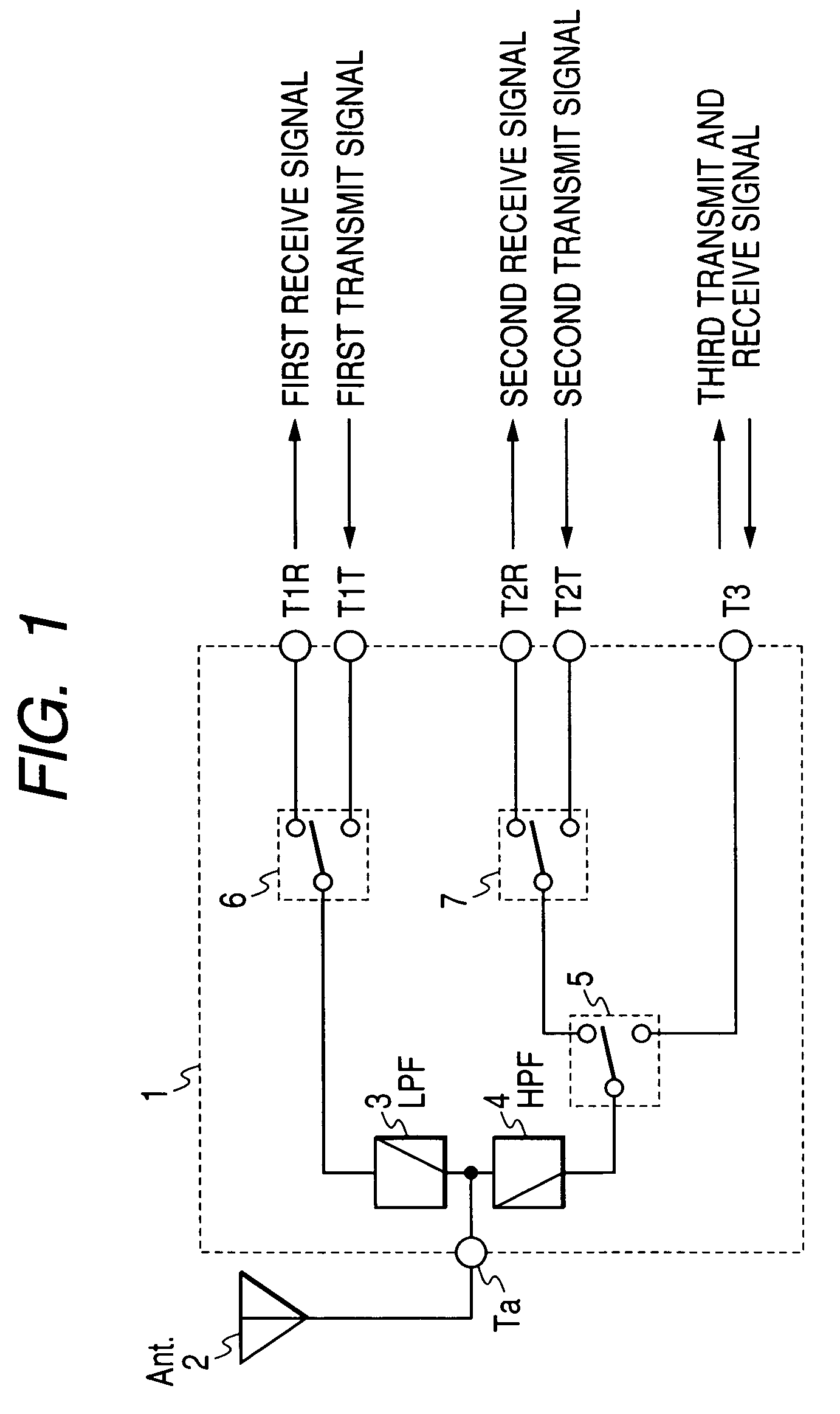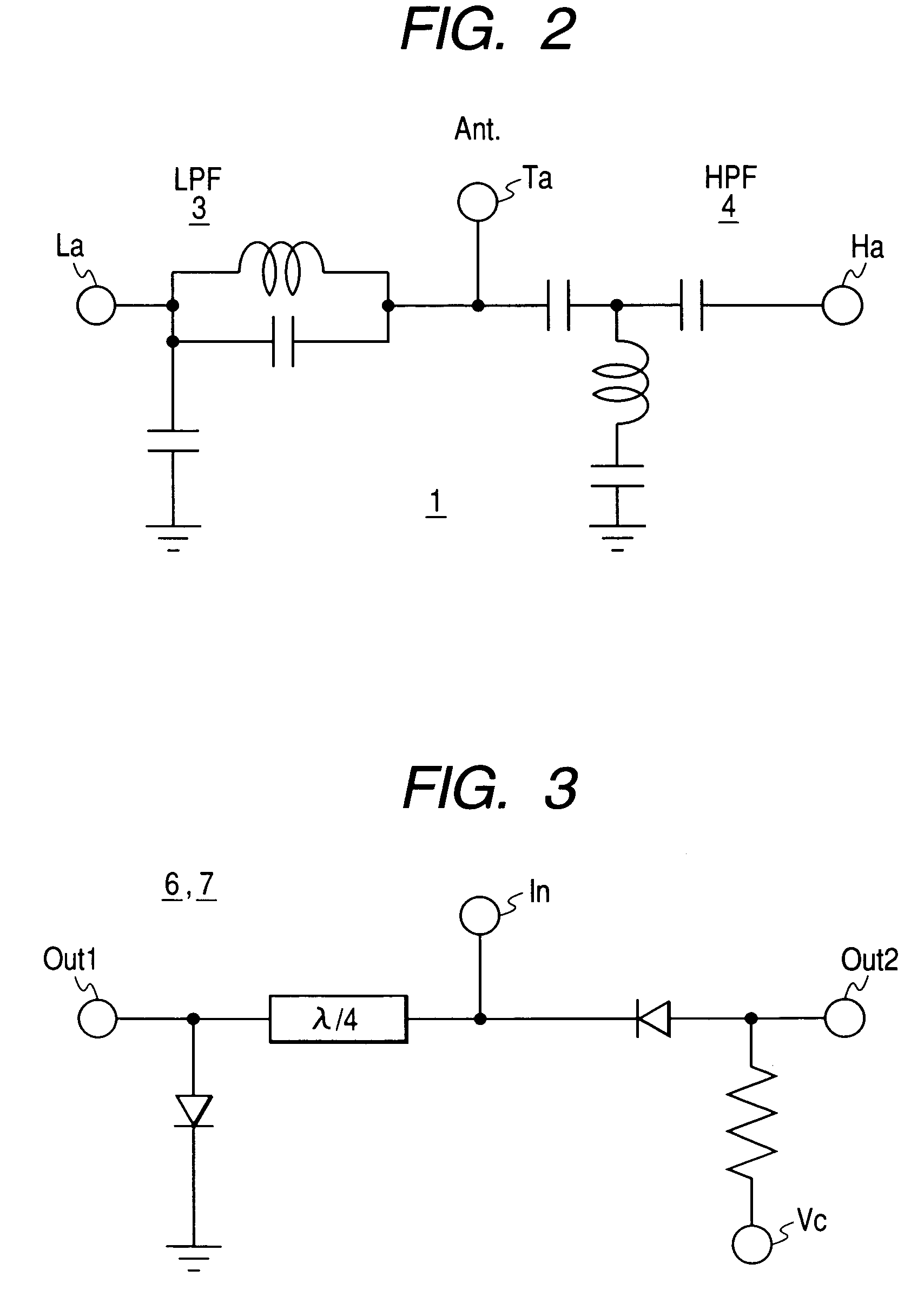Antenna sharing device and wireless communication terminal using the same
a wireless communication terminal and sharing device technology, applied in the direction of radio transmission, transmission monitoring, electrical equipment, etc., can solve the problems of increasing the number of components, difficult to unify such multiplex systems, and complicated circuits
- Summary
- Abstract
- Description
- Claims
- Application Information
AI Technical Summary
Benefits of technology
Problems solved by technology
Method used
Image
Examples
embodiment 1
[0034]First, a most basic configuration of an antenna sharing device as shown in FIG. 1 will be described as a first embodiment of the present invention. Referring to FIG. 1, it is considered important to use appropriate combinations of signal bands, indicated as the first, second and third transmit and receive signals in FIG. 1, and communication systems; for example, combinations of the first signal band and a GSM (Global System for Mobile Communications) system, the second signal band and a DCS (Digital Cellular System) system, and the third signal band and a WCDMA (Wideband Code Division Multiple Access) system.
[0035]The present embodiment will be described based on the above three combinations. The transmit signal frequency band and receive signal frequency band used by the GSM system are from 880 MHz to 915 MHz and from 925 MHz to 960 MHz, respectively. The transmit signal frequency band and receive signal frequency band used by the DCS system are from 1710 MHz to 1785 MHz and...
embodiment 2
[0077]Next, a second embodiment of the present invention will be described with reference to FIG. 9. In the configuration shown in FIG. 9, a GSM receive filter 8, a DCS receive filter 9, and a WCDMA diplexer in which a CDMA receive filter 10 and a WCDMA transmit filter 11 are connected in parallel are disposed downstream of the switches.
[0078]These filters may comprise a combination of SAW (Surface Acoustic Wave), FBAR (Filmed Bulk Acoustic Resonator) and SMR (Solidly Mounted Resonator) filters.
[0079]The present embodiment, like the first embodiment, can provide an inexpensive and practical antenna sharing device which meets requirements in terms of transmitter distortion characteristic and ESD resistivity.
embodiment 3
[0080]Next, a third embodiment of the present invention will be described. In introducing the first and second embodiments of the present invention, superiority of the present invention was described based on, for simplicity of explanation, a dual-mode, triple-band configuration for using GSM, DCS and WCDMA signals.
[0081]However, it is not only when a dual-mode, triple-band configuration is used that the superiority of the present invention is effective. The present invention is as effective as in the first and second embodiments also when a dual-mode, quintet band configuration is used.
[0082]Namely, it is effective also when a dual-mode, quintet band configuration as shown in FIG. 10 is used with the configuration including a GSM filter circuit (8-1) and a GSM-850 filter circuit (8-2) connected in parallel downstream of a high-frequency switch 6, a DCS filter circuit (9-1) and a PCS filter circuit (9-2) connected in parallel downstream of a high-frequency switch 7, and a WCDMA filt...
PUM
 Login to View More
Login to View More Abstract
Description
Claims
Application Information
 Login to View More
Login to View More - R&D
- Intellectual Property
- Life Sciences
- Materials
- Tech Scout
- Unparalleled Data Quality
- Higher Quality Content
- 60% Fewer Hallucinations
Browse by: Latest US Patents, China's latest patents, Technical Efficacy Thesaurus, Application Domain, Technology Topic, Popular Technical Reports.
© 2025 PatSnap. All rights reserved.Legal|Privacy policy|Modern Slavery Act Transparency Statement|Sitemap|About US| Contact US: help@patsnap.com



